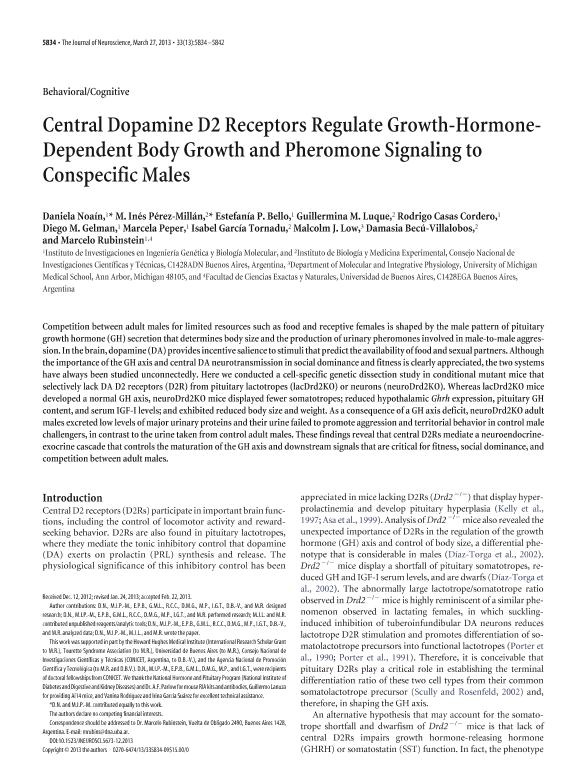Mostrar el registro sencillo del ítem
dc.contributor.author
Noain, Daniela Maria Clara

dc.contributor.author
Pérez Millán, María Inés

dc.contributor.author
Bello Gay, Estefania Pilar

dc.contributor.author
Luque, Guillermina Maria

dc.contributor.author
Casas Cordero, Rodrigo
dc.contributor.author
Gelman, Diego Matias

dc.contributor.author
Peper, Marcela

dc.contributor.author
Isabel Garcia-tornadu

dc.contributor.author
Low, Malcolm J.

dc.contributor.author
Becu, Damasia

dc.contributor.author
Rubinstein, Marcelo

dc.date.available
2015-11-02T16:26:34Z
dc.date.issued
2013-03-27
dc.identifier.citation
Noain, Daniela Maria Clara; Pérez Millán, María Inés; Bello Gay, Estefania Pilar; Luque, Guillermina Maria; Casas Cordero, Rodrigo; et al.; Central Dopamine D2 Receptors Regulate Growth-HormoneDependent Body Growth and Pheromone Signaling to Conspecific Males; Society For Neuroscience; Journal Of Neuroscience; 33; 13; 27-3-2013; 5834-5842
dc.identifier.issn
0270-6474
dc.identifier.uri
http://hdl.handle.net/11336/2627
dc.description.abstract
Competition between adult males for limited resources such as food and receptive females is shaped by the male pattern of pituitary growth hormone (GH) secretion that determines body size and the production of urinary pheromones involved in male-to-male aggression. In the brain, dopamine (DA) provides incentive salience to stimuli that predict the availability of food and sexual partners. Although
the importance of the GH axis and central DA neurotransmission in social dominance and fitness is clearly appreciated, the two systems have always been studied unconnectedly. Here we conducted a cell-specific genetic dissection study in conditional mutant mice that selectively lack DA D2 receptors (D2R) from pituitary lactotropes (lacDrd2KO) or neurons (neuroDrd2KO). Whereas lacDrd2KO mice developed a normal GH axis, neuroDrd2KO mice displayed fewer somatotropes; reduced hypothalamic Ghrh expression, pituitary GH
content, and serum IGF-I levels; and exhibited reduced body size and weight. As a consequence of a GH axis deficit, neuroDrd2KO adult males excreted low levels of major urinary proteins and their urine failed to promote aggression and territorial behavior in control male challengers, in contrast to the urine taken from control adult males. These findings reveal that central D2Rs mediate a euroendocrineexocrine cascade that controls the maturation of the GH axis and downstream signals that are critical for fitness, social dominance, and
competition between adult males.
dc.format
application/pdf
dc.language.iso
eng
dc.publisher
Society For Neuroscience

dc.rights
info:eu-repo/semantics/openAccess
dc.rights
Atribución-NoComercial-CompartirIgual 2.5 Argentina (CC BY-NC-SA 2.5 AR)
dc.rights.uri
https://creativecommons.org/licenses/by-nc-sa/2.5/ar/
dc.subject
Dopamine D2 Receptor
dc.subject
Growth Hormone
dc.subject
Mice Inbred Balb C57bl
dc.subject
Pituitary Gland
dc.subject.classification
Neurociencias

dc.subject.classification
Medicina Básica

dc.subject.classification
CIENCIAS MÉDICAS Y DE LA SALUD

dc.subject.classification
Endocrinología y Metabolismo

dc.subject.classification
Medicina Clínica

dc.subject.classification
CIENCIAS MÉDICAS Y DE LA SALUD

dc.title
Central Dopamine D2 Receptors Regulate Growth-HormoneDependent Body Growth and Pheromone Signaling to Conspecific Males
dc.type
info:eu-repo/semantics/article
dc.type
info:ar-repo/semantics/artículo
dc.type
info:eu-repo/semantics/publishedVersion
dc.date.updated
2016-03-30 10:35:44.97925-03
dc.identifier.eissn
1529-2401
dc.journal.volume
33
dc.journal.number
13
dc.journal.pagination
5834-5842
dc.journal.pais
Estados Unidos

dc.journal.ciudad
Washington
dc.description.fil
Fil: Noain, Daniela Maria Clara. Consejo Nacional de Investigaciones Científicas y Técnicas. Instituto de Investigaciones En Ingeniería Genética y Biología Molecular; Argentina
dc.description.fil
Fil: Pérez Millán, María Inés. Consejo Nacional de Investigaciones Científicas y Técnicas. Instituto de Biología y Medicina Experimental (i); Argentina
dc.description.fil
Fil: Bello Gay, Estefania Pilar. Consejo Nacional de Investigaciones Científicas y Técnicas. Instituto de Investigaciones En Ingeniería Genética y Biología Molecular; Argentina
dc.description.fil
Fil: Luque, Guillermina Maria. Consejo Nacional de Investigaciones Científicas y Técnicas. Instituto de Biología y Medicina Experimental (i); Argentina
dc.description.fil
Fil: Casas Cordero, Rodrigo. Consejo Nacional de Investigaciones Científicas y Técnicas. Instituto de Investigaciones En Ingeniería Genética y Biología Molecular; Argentina
dc.description.fil
Fil: Gelman, Diego Matias. Consejo Nacional de Investigaciones Científicas y Técnicas. Instituto de Investigaciones En Ingeniería Genética y Biología Molecular; Argentina
dc.description.fil
Fil: Peper, Marcela. Consejo Nacional de Investigaciones Científicas y Técnicas. Instituto de Investigaciones En Ingeniería Genética y Biología Molecular; Argentina
dc.description.fil
Fil: Isabel Garcia-tornadu. Consejo Nacional de Investigaciones Científicas y Técnicas. Instituto de Biología y Medicina Experimental (i); Argentina
dc.description.fil
Fil: Low, Malcolm J.. Michigan State University; Estados Unidos;
dc.description.fil
Fil: Becu, Damasia. Consejo Nacional de Investigaciones Científicas y Técnicas. Instituto de Biología y Medicina Experimental (i); Argentina
dc.description.fil
Fil: Rubinstein, Marcelo. Consejo Nacional de Investigaciones Científicas y Técnicas. Instituto de Investigaciones En Ingeniería Genética y Biología Molecular; Argentina
dc.journal.title
Journal Of Neuroscience

dc.relation.alternativeid
info:eu-repo/semantics/altIdentifier/doi/http://dx.doi.org/10.1523/JNEUROSCI.5673-12.2013
dc.relation.alternativeid
info:eu-repo/semantics/altIdentifier/url/http://www.jneurosci.org/content/33/13/5834.long
Archivos asociados
